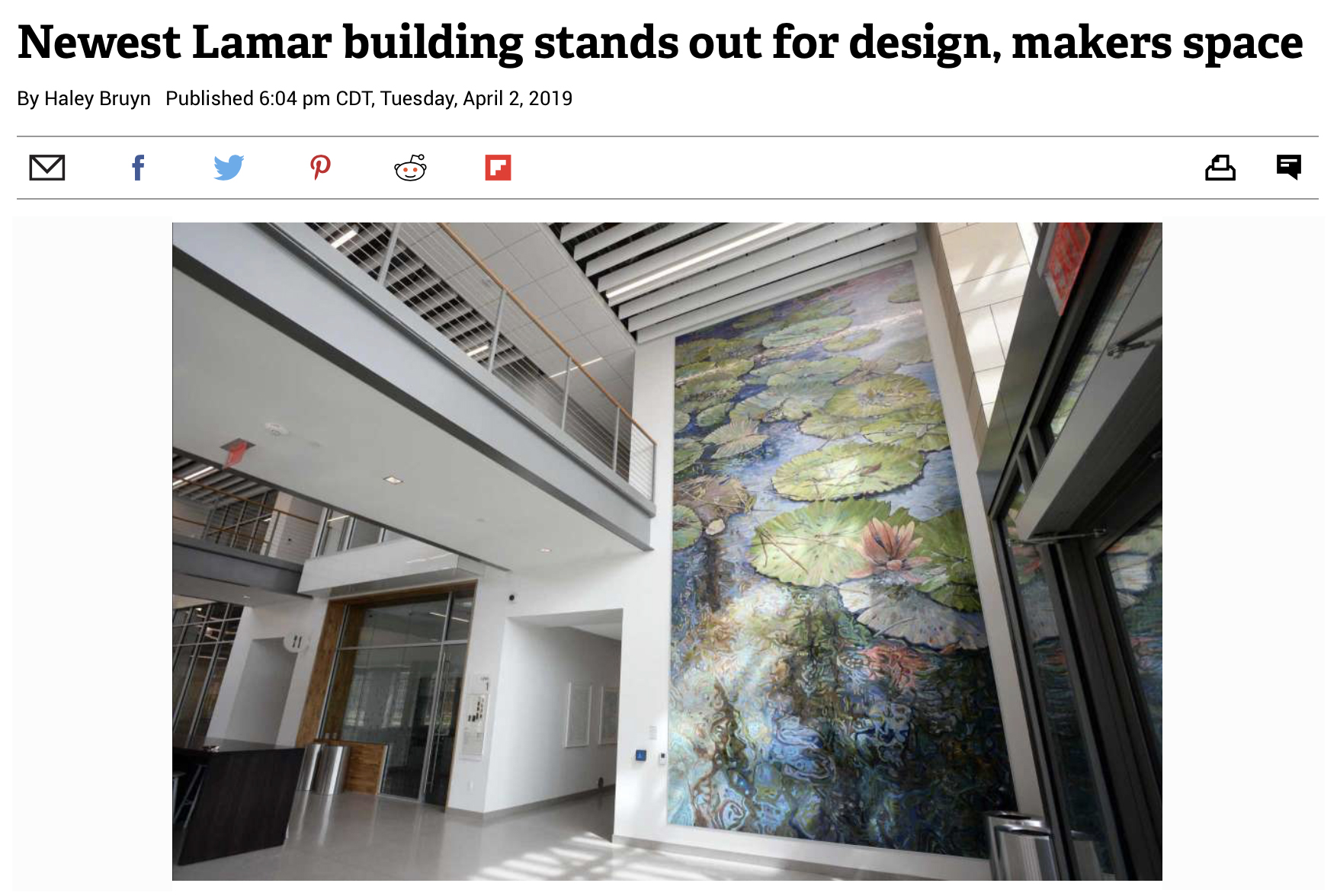Newest Lamar building stands out for design, makers space
/Beaumont Enterprise wrote an article about the new Science & Technology building at Lamar University. The article mentions the 25-by-12 foot mosaic “and We Waltz with Water” created for the building. The mosaic features a Southeast Texas swamp with lily pads and a body of rippling water. Check out the full article below!
Aside from being the first entirely academic building built at Lamar University in some 40 years, the $65 million Science and Technology Building boasts a state-of-the-art makers space and a design unlike any previous structure on the Beaumont campus.
The interdisciplinary building was designed in part to promote collaboration between the different degree programs, Lamar spokeswoman Shelly Vitanza said.
The building officially opens on Wednesday with a 1 p.m. ceremony.
“I think it’s going to be a real hangout space,” Vitanza said. “It’s very inviting.”
The natural light permeating the building creates an atmosphere that she called soft and homey.
Large teaching labs and smaller workrooms, along with upgraded traditional classrooms, will offer students more hands-on experience and instruction, Vitanza said.
The maker’s space boasts the equipment students need to take their ideas into the real world, Vitanza said, allowing them an opportunity to “get their hands dirty” fabricating with 3-D printers and other tools.
Some interdisciplinary student research teams have already been approved to use the space to work on projects, even though classes will not be held in the building until the fall semester.
The four projects approved so far tackle issues like the lack of health care in rural areas and the effect of contaminated floodwaters on coastal ecosystems, with students majoring in everything from nursing to biology to engineering.
“Everyone will use the building,” Vitanza said.
Lamar Chief Financial Officer Craig Ness said the recent and continuing upgrades to the campus are to ensure the longevity of the university.
“It’s part of what you have to do to be a good steward of the institution,” Ness said. “You look and see what you have to do to make the future of the university work.”
Near the Science and Technology Building, the Wayne A. Reaud Administration & Honors College, the Center for Innovation, Commercializiation and Entrepreneurship and , across campus, the new Setzer Student Center were all part of the effort to improve the impression given to those pulling into Lamar.
“It begins to present a more modern look to the campus,” Ness said. “If you come in off Rolfe Christopher, even without anything else being done, your impression is, ‘We’re coming up to a campus.’”
Vitanza said there are bright, open spaces throughout the building where students can gather to collaborate, read or study and an honor system based “micro market,” for snacks where students can select their goods and check themselves out.
“I just took a former student on a tour and he said he just couldn’t believe this was on the Lamar University Campus,” Vitanza said adding that the alum called it “absolutely gorgeous.”
Vitanza said those who have toured the building were consistently “wowed.”
Because the Texas State University Systems allows for 1 percent of the total budget to be used for art, a committee commissioned pieces to reflect the purpose of the new building.
A 25-foot-by-12-foot tile mosaic mural by Dixie Friend Gay greets those who enter the building.
“It’s water and air and all the natural resources that humankind cannot live without,” Vitanza said. “It’s a Southeast Texas swamp, with lily pads and water — just stunning.”
Another piece, a 14-foot tall kinetic statue by 92-year-old New Orleans-based artist Lin Emery, stands on the grounds slowly shifting and changing with the breeze.
Vitanza said the building’s design, art and function set it apart from every other building in Southeast Texas.
Ness said other less noticeable improvements are being made around campus as well, though most are on an “as needed” basis.
He cited a move last summer to dedicate $500,000 each year to renovate classrooms determined by committee to be the most deserving.
Improvements are also being made campuswide to ensure compliance with the Americans with Disabilities Act, making crosswalks and older buildings fully accessible.

